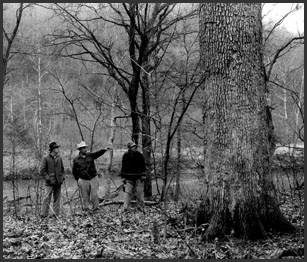L-A-D Foundation - Land Stewardship in the Missouri Ozark Highlands Since 1962
L-A-D Foundation - Land Stewardship in the Missouri Ozark Highlands Since 1962


Financial Comparisons
Why would you want to leave a healthy 12-inch tree standing in the forest? We are often asked this question since even-aged management would cut this tree along with all the others. Over a 20-year period a healthy 12-inch tree left in the forest would grow to be 16-inches in diameter (based on growth averages for Ozark forests). For economic comparisons, in 1980 that 12-inch tree would have been worth about $3.15, however, 20 years later that same tree (now 16 inches in diameter) would have been worth about $31.83. This example uses average timber prices, based simply on volume. Beyond simple volume increases, a landowner can receive even more income for larger, high quality (grade) logs which are used for the highest quality wood products.
Uneven-aged forest management uses periodic harvests which remove individual trees, producing income while continuing to protect the forests most valuable timber assets for their increasing long-term value. High quality, large-diameter trees take long periods of time to grow in maturity and value.
In the Ozarks a scarlet oak may grow to maturity in 60-80 years, shortleaf pine may mature at 120-150 years, while a white oak may take 200 or more years to mature. Uneven-aged management can establish and then maintain a canopy of these mixed species and various aged trees. It uses shorter periods of time between harvests to log only those trees which are mature or not growing well. The best trees are left to accumulate value.

Market Prices
Since 1950 market price increases demonstrate that private landowners can produce high economic returns from this more conservative forest management technique. From 1950 to 1975 market prices nearly tripled, outpacing inflation. Even more interesting is that during the 25-year period 1975 to 2000, the price for standing trees increased from $12.59 per 1000 board feet of merchantable sawlogs to $185 per 1000 board feet.
This analysis simply reflects the changing value for the same sawlogs over time. By leaving a healthy tree to continue to grow in the forest it also increases in volume. When compared with other market opportunities, conservative forest management is clearly market competitive. Here is another way to compare the economic return as a result of forest management techniques.
Suppose two identical acres had been cut in 1975, using a clearcut on one and uneven-aged management on the other. The profits were invested at an equal rate. Combining the amount invested from the first single-tree selection harvest in 1975 along with the current net proceeds from a second harvest, the total amount received by the landowner is nearly double that from clearcutting ($303 versus $178). (This analysis includes professional management fees.) Remember here that once an acre of forest is clearcut it will require a period of at least 80-100 years to regrow and during this same period of time uneven-aged management is applied four times.
During one individual's lifetime a well-managed forest can return ever-increasing amounts of income. The financial rewards are great and every forested acre remains a true forest.
Maximum Sustainable Volume
One measure of the forest which is of particular interest from an economic viewpoint is the potential of any given acre of the forest to produce and hold a maximum sustainable volume. At least for Pioneer Forest, managed using the uneven-aged technique of single-tree selection harvests, we still have not realized what the potential average yield per acre will be. Since 1957, the average standing volume per acre has more than tripled and this has been under our forest management and harvest regime.
This means that we still have not realized the maximum potential for harvest using uneven-aged management techniques. We expect at some point to see the increase in standing volume change, either to begin to level off, or possibly to decline and then level off, which will indicate the maximum sustainable volume, or carrying capacity, for a forest under this management system in the Ozarks.
Click above to view Pioneer Forest brochure or right click and "save as" to save.
© 2013-2023 L-A-D FOUNDATION ♦ 725 KINGSLAND AVE., SUITE 100, ST. LOUIS, MO 63130 ♦ 314-621-0230 ♦ EMAIL: INFO@LADFOUNDATION.ORG
PIONEER FOREST ♦ PO BOX 497, SALEM, MO 65560 ♦ 573-729-4641
♦ SEE PRIVACY POLICY
This site maintained by Craig Technology Consulting • 201 E. 4th St. • Salem, Missouri 65560 • PH 573.453.2322